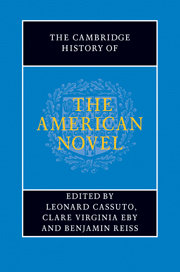Book contents
- Frontmatter
- General Introduction
- PART ONE INVENTING THE AMERICAN NOVEL
- PART TWO REALISM, PROTEST, ACCOMMODATION
- PART THREE MODERNISM AND BEYOND
- Introduction: modernism and beyond
- 37 Stein, Hemingway, and American modernisms
- 38 The Great Gatsby and the 1920s
- 39 Philosophy and the American novel
- 40 Steinbeck and the proletarian novel
- 41 The novel, mass culture, mass media
- 42 Wright, Hurston, and the direction of the African American novel
- 43 Ellison and Baldwin: aesthetics, activism, and the social order
- 44 Religion and the twentieth-century American novel
- 45 Faulkner and the Southern novel
- 46 Law and the American novel
- 47 Twentieth-century publishing and the rise of the paperback
- 48 The novel of crime, mystery, and suspense
- 49 US novels and US wars
- 50 Science fiction
- 51 Female genre fiction in the twentieth century
- 52 Children's novels
- 53 The American novel and the rise of the suburbs
- 54 The Jewish great American novel
- 55 The Beats and the 1960s
- 56 Literary feminisms
- 57 Reimagining genders and sexualities
- PART FOUR CONTEMPORARY FORMATIONS
- A selected bibliography
- Index
55 - The Beats and the 1960s
from PART THREE - MODERNISM AND BEYOND
Published online by Cambridge University Press: 28 July 2011
- Frontmatter
- General Introduction
- PART ONE INVENTING THE AMERICAN NOVEL
- PART TWO REALISM, PROTEST, ACCOMMODATION
- PART THREE MODERNISM AND BEYOND
- Introduction: modernism and beyond
- 37 Stein, Hemingway, and American modernisms
- 38 The Great Gatsby and the 1920s
- 39 Philosophy and the American novel
- 40 Steinbeck and the proletarian novel
- 41 The novel, mass culture, mass media
- 42 Wright, Hurston, and the direction of the African American novel
- 43 Ellison and Baldwin: aesthetics, activism, and the social order
- 44 Religion and the twentieth-century American novel
- 45 Faulkner and the Southern novel
- 46 Law and the American novel
- 47 Twentieth-century publishing and the rise of the paperback
- 48 The novel of crime, mystery, and suspense
- 49 US novels and US wars
- 50 Science fiction
- 51 Female genre fiction in the twentieth century
- 52 Children's novels
- 53 The American novel and the rise of the suburbs
- 54 The Jewish great American novel
- 55 The Beats and the 1960s
- 56 Literary feminisms
- 57 Reimagining genders and sexualities
- PART FOUR CONTEMPORARY FORMATIONS
- A selected bibliography
- Index
Summary
The history of the “Beat” novelists and their descendants in the 1960s really begins somewhere in mid nineteenth-century American fiction and poetry, particularly with Melville and Whitman. The seemingly autobiographical invocations to the self and a sprawling, erotic landscape found a willing ear in both Jack Kerouac and Allen Ginsberg. Kerouac's empathy with seekers, wanderers, and outcasts hearkens to Melville's turning to “mariners, renegades, and castaways,” as he called his characters in Moby-Dick (1851); all of Kerouac's writing has the force of being a new “Song of the Open Road,” if not, more accurately, songs of the open roads. The analogies between the nineteenth-century American writers and the Beats – both in style and thought – also reveal the extent to which all had, though in different ways, transcendent, if not religious aims. Any notion that the Beats were merely about being “rebels” or “cool” or “counterculture” ignores the fundamental positive aim apparent in almost all their writing – a desire for some kind of liberation toward a better and spiritual plane of existence. However much that vision became denigrated, parodied, or sold out, it was a fundamental part of the writing from the beginning – even in the very conception of Beat. Whether Kerouac was writing about his perennial muse Neal Cassady, or Burroughs was writing about “junk,” the inscrutable things, the ultimate things of life, remained in the forefront of their most outrageous visions.
- Type
- Chapter
- Information
- The Cambridge History of the American Novel , pp. 909 - 924Publisher: Cambridge University PressPrint publication year: 2011



